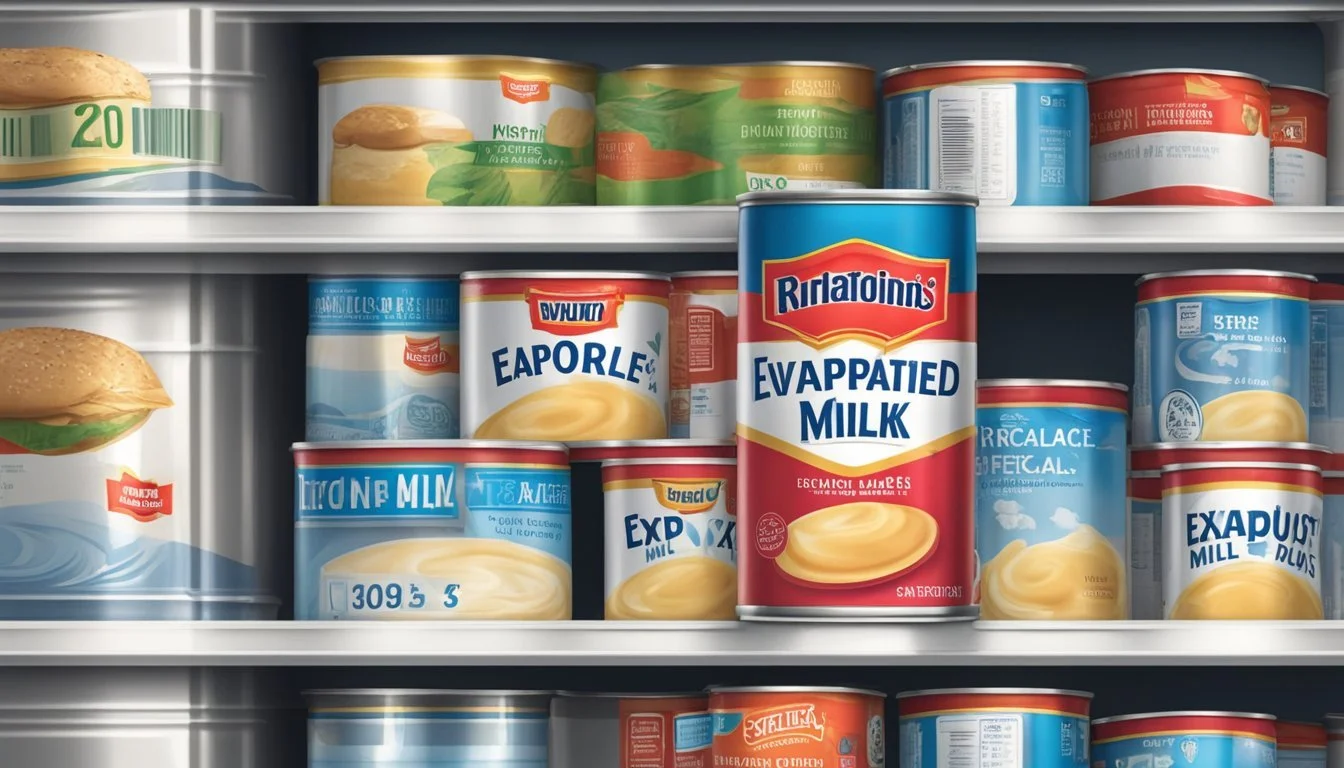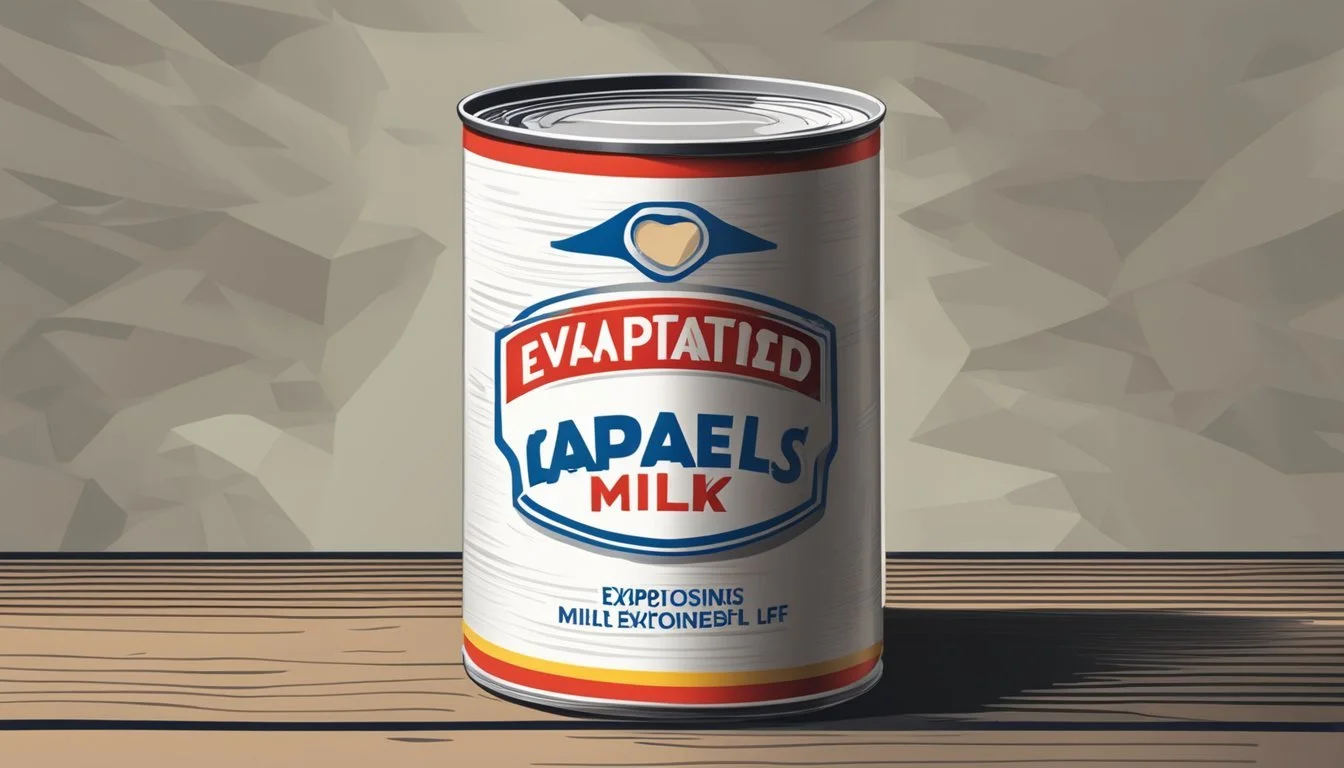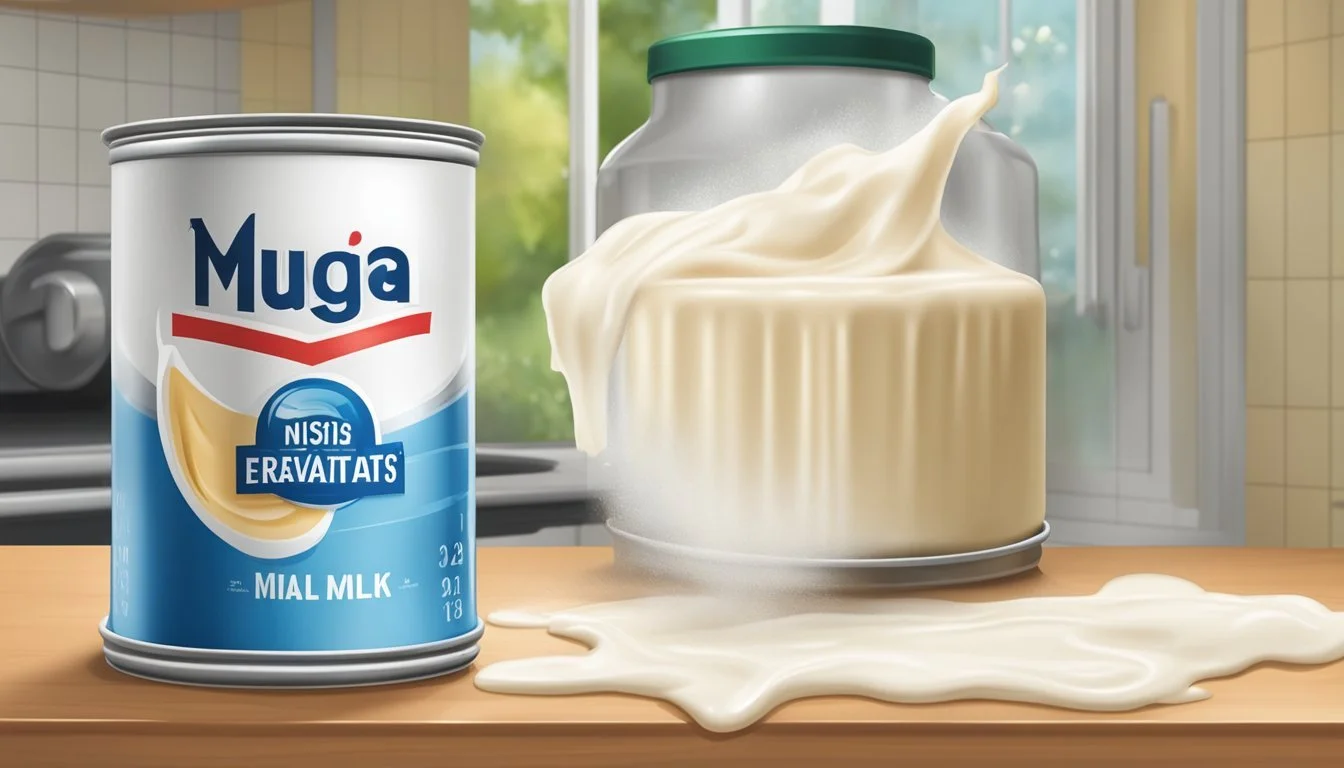How Long Does Evaporated Milk Last?
Shelf Life and Storage Tips
Evaporated milk (how long does evaporated milk last?), a shelf-stable dairy product, undergoes a process where approximately 60% of its water content is removed. This process not only concentrates the milk but also affords it a much longer shelf life compared to regular milk. The resulting product offers a creamier texture and richer flavor, perfect for cooking and baking purposes. In its unopened state, canned evaporated milk (how long does canned evaporated milk last?) can typically last between 6 to 18 months, with many brands indicating a best-by date on the packaging.
Once the seal is broken, however, the shelf life of evaporated milk reduces significantly. It needs to be refrigerated and is best consumed within 3 to 5 days to maintain optimal quality and safety. Although evaporated milk can last beyond this period, it is important to note that the taste, texture, and nutritional value may start to deteriorate. In order to extend its usage, some choose to freeze evaporated milk, a method that can extend the product's life for up to 3 months without severely impacting its quality.
Understanding Evaporated Milk
Evaporated milk is a form of concentrated milk that's known for its extended shelf life and distinct, slightly caramelized flavor. This product is created by removing a significant percentage of water from fresh milk.
Composition and Properties
Evaporated milk contains about 60% less water than regular milk, concentrating the nutrients and flavor. Its composition includes:
Proteins: Key for maintaining muscle tissue
Carbohydrates: A primary energy source
Fats: Can vary based on whether it's regular or reduced-fat
Vitamins and Minerals: Such as calcium and vitamin D
The reduction in water content not only concentrates these components but also reduces the likelihood of microbial growth, aiding in preservation. The sterilization process, where the milk is heated to a high temperature, further ensures that the milk is free of pathogens.
Shelf-Stable Characteristics
Evaporated milk is recognized for being shelf-stable, which means it can safely be stored unopened at room temperature for a significant period. Key factors that contribute to its shelf life include:
Packaging in cans: Provides an airtight and light-resistant environment
Lack of water: Low water content makes it less hospitable to bacteria
Sterilization: Kills bacteria and inactivates enzymes that could spoil the milk
When stored in a cool and dry place, away from direct light and at stable temperatures, an unopened can of evaporated milk can last well past the printed expiration date, typically ranging from 6 to 18 months, retaining its quality and safety. Once opened, it should be transferred to an airtight container and kept in the fridge, where it remains good for use for a few days.
Shelf Life and Expiration
Evaporated milk's longevity depends largely on proper storage conditions and adherence to the best-by dates provided by manufacturers.
Unopened Shelf Life
Unopened containers of evaporated milk generally last for 12 to 18 months past the date of manufacture when stored in a cool, dry pantry. The best-by date stamped on the can is a helpful indicator of peak quality but is not an absolute expiration date. If the can is undamaged and stored correctly, evaporated milk can remain safe to consume for a period beyond this date. However, its quality may decline, so it's important to inspect it for signs of spoilage before use.
Opened Shelf Life
Once opened, evaporated milk's shelf life diminishes considerably. An opened can should be transferred to an airtight container if not used entirely and should be refrigerated immediately. Under refrigeration, it typically remains usable for up to 5 days. It is vital to ensure that the product is well-covered and the temperature is consistent to prevent spoilage.
Proper Storage Tips
To maintain the quality and extend the shelf life of evaporated milk, one needs to store it properly. Sealed cans require cool, dry conditions away from light, whereas leftovers demand refrigeration and an airtight environment.
Sealed Can Storage
A sealed can of evaporated milk should be stored in a cool, dry place such as a cupboard or pantry. It's essential to keep the can away from extreme temperatures and direct sunlight to prevent degradation of the milk's quality. Ideally, the storage area should have a stable temperature, free from fluctuations that could cause the milk to spoil prematurely.
Leftover Storage Methods
Once opened, evaporated milk needs to be refrigerated. Pour any leftovers into an airtight container to minimize exposure to air and other contaminants. Label the container with the current date to ensure usage within the optimal time frame, which is typically a few days post-opening. If a larger quantity remains, one may consider dividing it into smaller containers to avoid repeated warming of the entire batch.
Signs of Spoilage
Detecting spoilage in evaporated milk involves examining its appearance for any visual changes and assessing its smell and taste for indications of deterioration. It is crucial to recognize these signs promptly to ensure food safety and quality.
Visual Indicators
One should inspect the milk for:
Discoloration: Any deviation from the milk’s uniform creamy color, such as yellowing or browning, suggests spoilage.
Texture Changes: Evaporated milk should be fluid and smooth. The presence of lumps or a gelatinous consistency indicates it has gone bad.
Mold: The presence of mold, which can appear as spots or fuzzy patches on the surface, indicates bacterial growth and necessitates immediate discarding of the milk.
Olfactory and Taste Assessment
Before tasting, one must:
Smell: Spoiled evaporated milk emits an off, sour, or even putrid odor. A fresh can should have a mild, sweet smell typical of dairy.
Taste: Should the milk pass the smell test, a small sip must be taken to assess its flavor. Any sourness or an unpleasant aftertaste means the milk should be discarded. However, tasting should be the last resort after all other signs of spoilage have been considered due to safety reasons.
Using Evaporated Milk
Evaporated milk is a versatile dairy product that can be used directly from the can for cooking and baking or reconstituted to replace fresh milk in beverages.
Culinary Uses
In the kitchen, evaporated milk is known for its richness and creamier texture, which makes it an excellent ingredient for various dessert recipes and soups. Chefs and home cooks often incorporate evaporated milk into their baking processes to add a luxurious depth to cakes, cookies, and pies. It’s also a staple for savory dishes, where it contributes a thicker consistency and enhances flavor.
Desserts: Use as a base for custards (how long do custards last?), puddings, and pie fillings.
Soups: Add to thicken and enrich broths and creamy soups.
Baking: Employ in place of whole milk or cream for a denser, moist texture in cakes and bread.
Leftover evaporated milk doesn’t need to go to waste; it can be stored in the refrigerator and used in other recipes, such as tea or coffee to make them creamier or added to smoothies for an extra rich texture.
Reconstitution for Drinking
To reconstitute evaporated milk for drinking or to use as a substitute for regular milk, combine it with an equal amount of water. The result is a product that closely mirrors the taste and consistency of whole milk. Here’s a simple guideline:
Mix 1 part evaporated milk with 1 part water.
This reconstituted milk can be consumed on its own as a beverage, or used in tea and coffee to achieve similar results to using fresh milk. It can also be a stand-in for milk in any recipe that calls for it, offering a great alternative for those who might not have fresh milk at hand.
Freezing and Thawing Techniques
When it comes to preserving evaporated milk, one can utilize freezing techniques to extend its shelf life and thawing methods for later use, keeping in mind that the texture may change due to the separation of components.
Freezing Evaporated Milk
To freeze evaporated milk:
Pour the milk into an airtight container, leaving about half an inch at the top to account for expansion during freezing.
Alternatively, one can use an ice cube tray to freeze evaporated milk in smaller, convenient portions.
It's important to note that while freezing can extend the lifespan of evaporated milk up to 6 months, its consistency might change. Upon thawing, one may observe that the milk has separated, but this usually doesn't affect its culinary uses.
Thawing and Using Frozen Milk
For thawing frozen evaporated milk:
The best method is to place the milk in the refrigerator for a day to allow it to thaw gradually.
Once thawed, if the milk has separated, simply stir or shake the container to reintegrate the milk as much as possible.
Using thawed evaporated milk is particularly suitable for cooking and baking, where texture differences due to separation become negligible. It is suggested to use the leftovers immediately after thawing to ensure quality and safety.
Special Considerations
In evaluating the shelf life of evaporated milk, one must consider not only storage and expiration but also individual dietary needs and its distinction from other milk products.
Allergies and Dietary Restrictions
Evaporated milk is unsweetened condensed milk which has had roughly 60% of its water content removed. As it is made from regular milk, individuals with lactose intolerance or dairy allergies should avoid it. Furthermore, for those on plant-based diets, soy milk (how long does soy milk last?) or other dairy-free alternatives should be used instead of evaporated milk. These alternatives should also be chosen with attention to expiration and proper storage.
Comparison with Other Milk Forms
Milk Form Shelf Life Unopened Shelf Life Opened Key Storage Consideration Regular Milk 5-7 days past sell-by date 3-5 days in fridge Refrigerate immediately Heavy Cream 2-3 weeks 5-7 days in fridge Keep refrigerated Powdered Milk 18 months to 2 years 7 days in fridge Store in a cool dry place Sweetened Condensed Milk 1 year past print date 1-2 weeks in fridge Seal tightly after opening Evaporated Milk 6-12 months past print date 3-5 days in fridge Store away from sunlight
It is crucial to note that evaporated milk lasts significantly longer than regular milk when unopened due to the removal of moisture and sterile canning processes. Once opened, it should ideally be consumed within 3-5 days when refrigerated, which is comparable to regular milk and slightly less than heavy cream. Unlike evaporated milk, dry milk or powdered milk, both of which have had all moisture removed, boast a much longer shelf life but should be used within a week once reconstituted. Sweetened condensed milk, which is similar to evaporated milk but contains added sugar, has a shelf life comparable to unsweetened evaporated milk unopened, but can last slightly longer once opened due to the preservative nature of sugar.
Frequently Asked Questions
When assessing the longevity of evaporated milk, one should consider brand differences and packaging standards, as well as guidelines for usage post-expiration. These factors are crucial in determining how long it remains suitable for consumption.
Impact of Brand and Packaging
Brands may vary slightly in their production process, which could influence shelf life; however, these variations are generally negligible in the context of evaporated milk's durability. The consistency in shelf life across different brands is largely due to standardized industry practices. What is important to note is the type of packaging. Evaporated milk is commonly sold in cans, which are hermetically sealed to keep the contents sterile. This type of packaging, when unopened and stored in optimal conditions—cool, dry, and away from direct sunlight—helps to ensure a stable shelf life that can extend well beyond the expiration date printed on the can, which typically ranges from 6 to 12 months.
Guidelines for storage:
Store in a cool, dry place.
Avoid direct sunlight.
After opening, transfer to an airtight container if not used immediately.
Refrigerate after opening for best quality.
Usage After Expiration Date
When it comes to using evaporated milk after its expiration date, guidelines must be observed to ensure quality and safety. An unopened can of evaporated milk can last beyond its expiration date, but it's critical to inspect the can for any signs of damage or spoilage, such as rust, dents, or swelling, which could indicate compromised integrity.
Once opened, evaporated milk should be transferred to an airtight container and stored in the refrigerator. It generally retains its best quality for 3 to 5 days after opening but might be safe to consume for a day or two beyond this if it has been stored correctly and shows no signs of spoilage. Signs to watch out for include an off-odor, discoloration, or unusual texture. Additional sugar or other ingredients do not notably extend the milk's shelf life.
Here is a brief checklist for post-expiration usage:
Check the can's condition (no swelling, rust, or dents).
Sniff for off-odors.
Look for any changes in color or texture.
Use within 3 to 5 days after opening when refrigerated.
Conclusion
Evaporated milk is a pantry staple known for its extended shelf life compared to fresh milk due to its reduced water content and sterilization process. Typically, manufacturers indicate that the shelf life of an unopened can ranges from 6 to 12 months past the printed expiration date, provided it's stored in a cool, dry place and the can is not damaged.
Once opened, evaporated milk should be transferred to an airtight container if not used immediately, and refrigerated to maintain quality. It's best to use it within 2 to 5 days for optimal freshness and taste. Upon opening, changes in taste, smell, or color can signal spoilage.
Here is a quick reference:
Shelf Life Unopened: 6 to 12 months past expiration date
Shelf Life Opened: 2 to 5 days when refrigerated
Spoilage Signs: Off-odor, discoloration
Consumers should inspect cans for any signs of compromise, such as swelling, rust, or deep dents. These can affect the product's safety and quality. In cases where the integrity of the can is questionable, it's best to err on the side of caution and avoid consumption.







